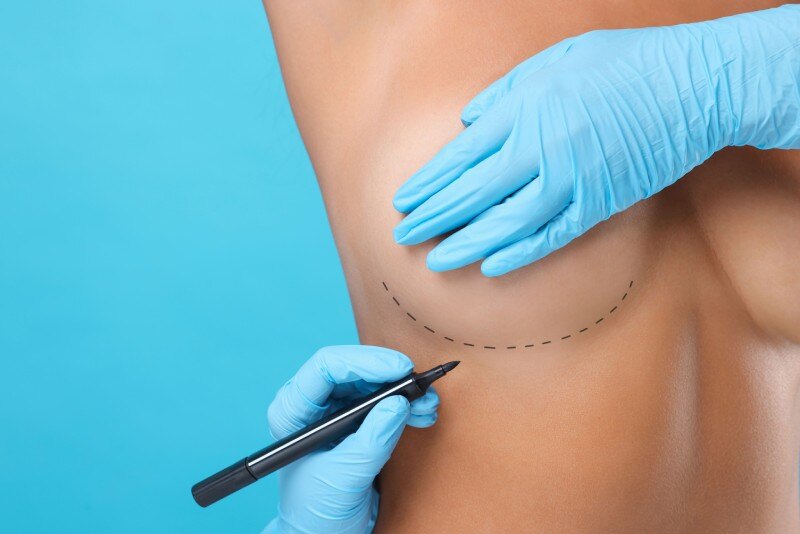Articles
Breast implant options in Singapore: what to know

Breast augmentation is a popular cosmetic procedure among women seeking to enhance the size and shape of their breasts. Whether for personal aesthetic desires or restoring breast volume lost after pregnancy or weight loss, understanding what breast augmentation entails is crucial.
If you are considering getting breast implants, then you can refer to this article as a guide on the types of implants and what you can expect during recovery.
Types of breast implants
Choosing the correct type of breast implant is a big decision in your breast augmentation journey. The two main types of breast implants are saline and silicone.
Saline implants
Saline breast implants are filled with sterile salt water. They are inserted empty and filled once in place, allowing for smaller incisions. If a saline implant ruptures, the body absorbs the saline solution harmlessly. These implants tend to have a firmer feel compared to silicone implants.
Silicone implants
Silicone implants are pre-filled with silicone gel, which more closely mimics the feel of natural breast tissue than saline. They are available in various shapes and sizes, providing a more natural appearance and feel.
However, if a silicone implant ruptures, the gel may remain within the implant shell or escape into the breast implant pocket, necessitating periodic MRI or ultrasound exams to ensure its integrity.
Gummy bear implants
Gummy bear implants are a type of silicone implant filled with a thicker, cohesive silicone gel. They maintain their shape even if the implant shell is broken, and they are also known for providing a more natural contour and feel.
Choosing the right implant size
A breast implant has to be the right size to achieve your desired aesthetic outcome. This decision involves considering your body type, current breast size, and your aesthetic goals.
Consultation and sizing
During the consultation, your surgeon will measure your chest wall and assess the elasticity of your breast skin to determine the best implant size. Using sizers and 3D imaging, you can visualise how different sizes will look on your body. It is important to choose a size that enhances your figure while maintaining a natural appearance.
Personal preferences and lifestyle
Your lifestyle and personal preferences play a significant role in this decision. Consider your activity level, as larger implants may interfere with physical activities. Additionally, think about your long-term goals and how you want your breasts to look and feel.
Surgical techniques and incision types
The surgical technique and type of incision used can impact the final result of your breast augmentation, as well as the recovery process. There are three common incision types:
Inframammary incision
The inframammary incision is made in the fold under the breast, providing the surgeon with optimal visibility and control during the procedure. This incision type is preferred for silicone implants and allows for precise placement.
Periareolar incision
The periareolar incision is made around the edge of the areola. This method allows for a well-concealed scar but may have a higher risk of affecting breastfeeding and nipple sensation.
Transaxillary incision
The transaxillary incision is made in the armpit, leaving no visible scar on the breast itself. This technique requires specialised equipment and skill but can be a good option for women concerned about scarring.
Transumbilical incision (TUBA)
Less commonly used is the transumbilical incision, which is made in the navel. The implants are inserted through a tunnel under the skin to the breast area. This technique is typically used for saline implants and leaves no visible breast scars.
Recovery after breast enhancement surgery
Understanding the recovery process is essential to prepare for the post-operative period and ensure a smooth healing journey.
Immediate postoperative period
After the breast augmentation surgery, you will be monitored in a recovery area before being allowed to go home. You will need someone to drive you home and stay with you for the first 24 to 48 hours. Pain, swelling, and bruising are expected during the initial days. Your surgeon will prescribe pain medication and provide detailed post-operative care instructions.
First few weeks
You should avoid strenuous activities and lifting heavy objects during the first few weeks. It’s crucial to follow your surgeon’s advice regarding wearing a surgical bra or compression garment to support your breasts as they heal. Most patients can return to work within a week, depending on the nature of their job.
Long-term recovery
Full recovery after breast enlargement can take several months, and the implants will settle into their final position. Regular follow-up appointments with your surgeon will ensure your recovery progresses. It’s essential to maintain a healthy lifestyle and avoid smoking, which can impede the healing process.
Choosing a qualified surgeon
Selecting a qualified and experienced surgeon is paramount to achieving the best results and minimising risks.
Ensure your surgeon is board-certified by the Singapore Medical Council (SMC) and a member of reputable professional organisations such as the Singapore Association of Plastic Surgeons (SAPS).
Choose a surgeon specialising in breast augmentation surgery with a proven track record of successful procedures. Reviewing before-and-after photos of previous patients can give you an idea of their aesthetic style and skill level.
Breast augmentation in Singapore
Choosing breast enhancement surgery is a significant decision, and we will support you every step of the way. At Polaris Plastic & Reconstructive Surgery, we are committed to providing personalised care and effective treatment.
Our team of MOH-accredited and board-certified surgeons has extensive experience in breast augmentation, ensuring that each patient receives the highest standard of care. We tailor each procedure to your needs, choosing the best implant type, size, and surgical technique to achieve your desired look.
Contact Form
At Polaris Plastic & Reconstructive Surgery, we provide the highest standards of plastic, reconstructive and aesthetic surgery services to suit the individual needs of each of our patients, placing their well-being and concerns at the center of a seamless, holistic interaction with our practice.
Visit us at
1 Orchard Boulevard #10-08 Camden Medical Centre, Singapore 248649
1 Orchard Boulevard #10-08 Camden Medical Centre, Singapore 248649
3 Mount Elizabeth, #08-09 Mount Elizabeth Medical Centre, Singapore 228510
6 Napier Rd, #08-01 Gleneagles Medical Center, Singapore 258499
Tel: +65 6737 4565 | Mobile: +65 8828 4565 | Email: clinic@polarisplasticsurgery.com | Business Hours: Mon - Fri: 9am - 6pm | Sat: 9am - 1pm | Sun/Ph: Closed
6 Napier Rd, #08-01 Gleneagles Medical Center, Singapore 258499
Tel: +65 6737 4565 | Mobile: +65 8828 4565 | Email: clinic@polarisplasticsurgery.com | Business Hours: Mon - Fri: 9am - 6pm | Sat: 9am - 1pm | Sun/Ph: Closed
Insurance Panels











